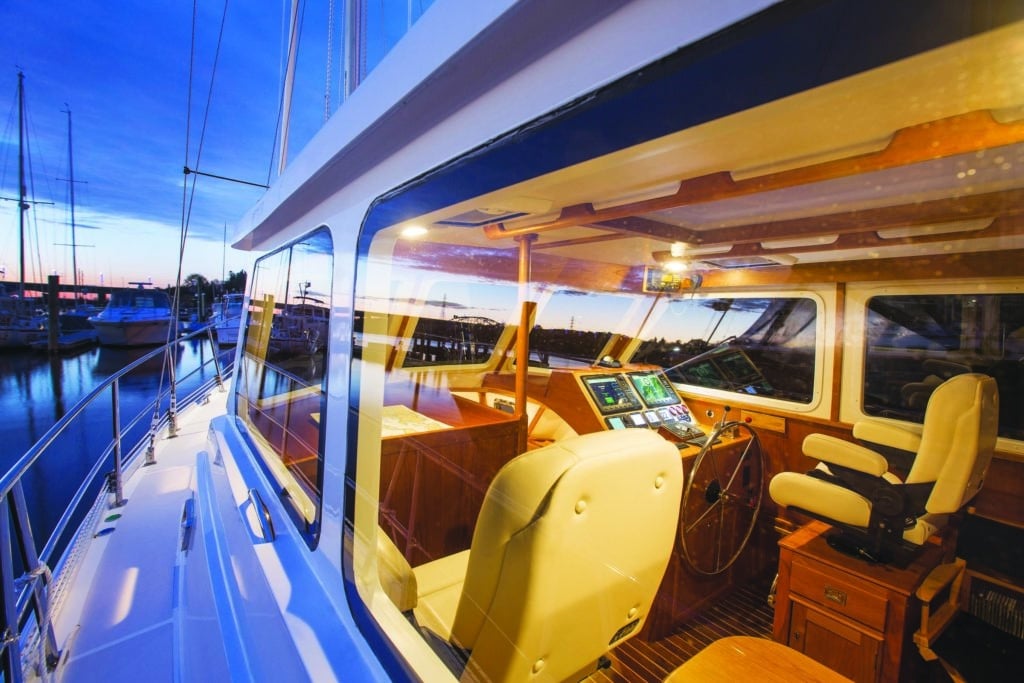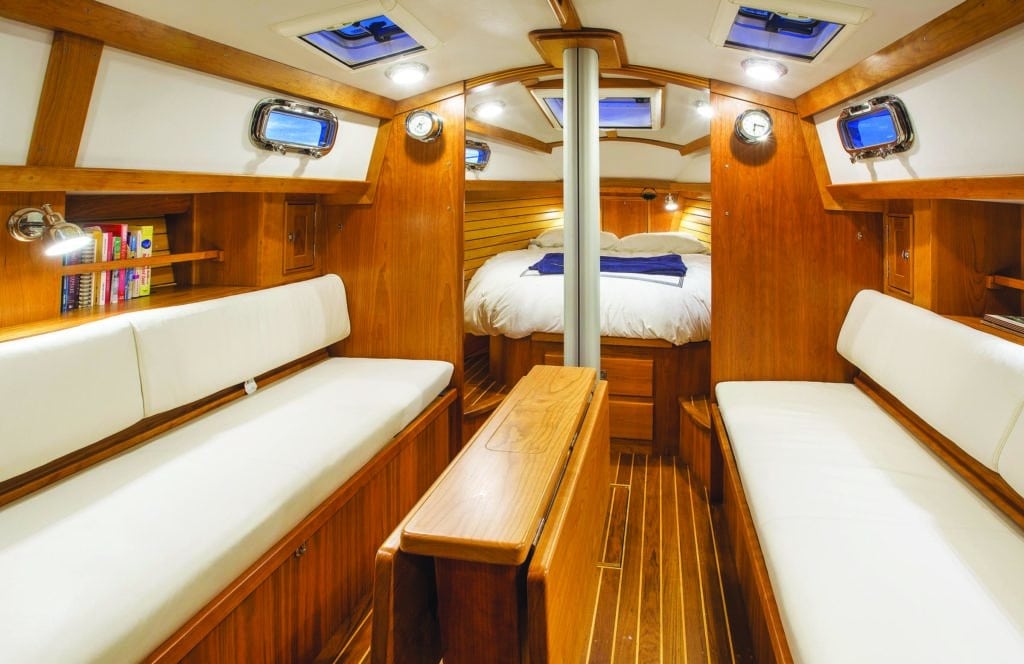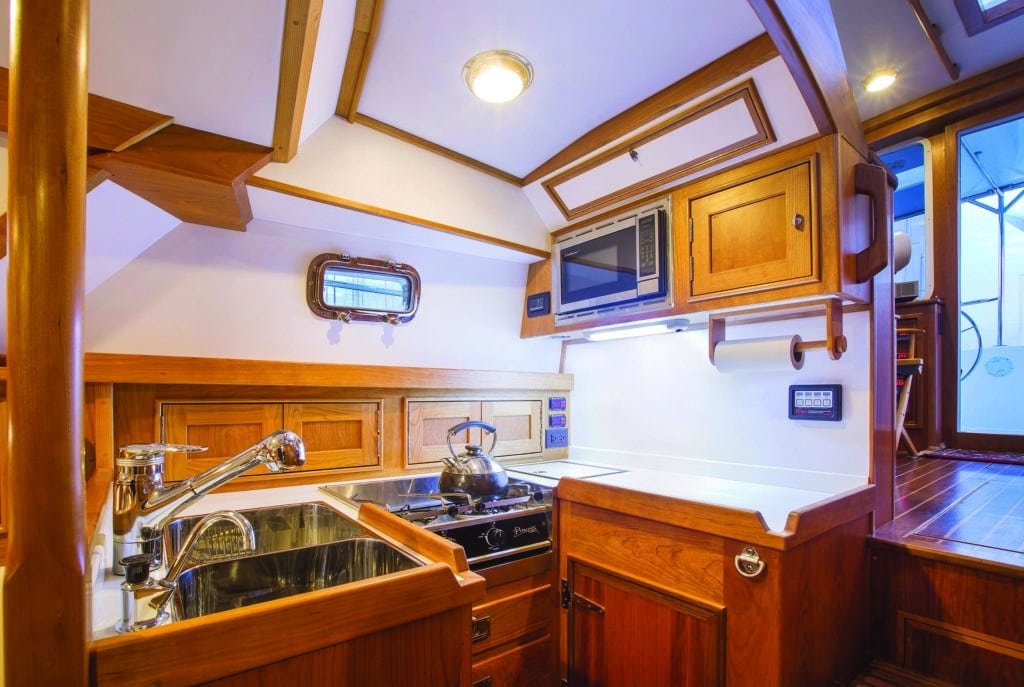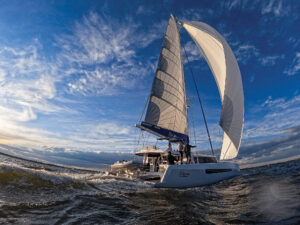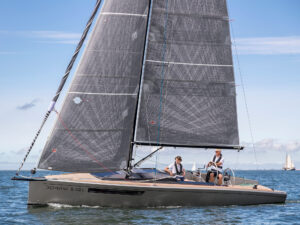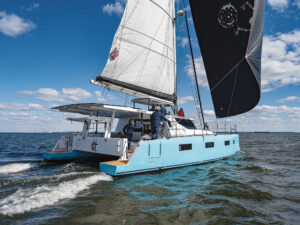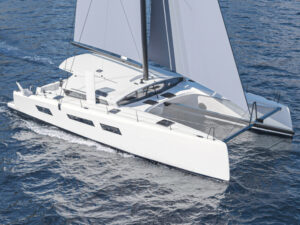I will be the first to admit that I’m a fair-weather sailor. Balmy breezes are my thing, so although I love to be out on the water, you wouldn’t typically find me sailing on a brisk November day. But that’s when the opportunity arose to take the new Shannon 38 HPS out for a spin on Rhode Island’s Mount Hope Bay, where I discovered that my love of sailing trumped even my love of warmth — and fortunately I could enjoy both.
The Shannon 38 HPS, which stands for High Power Sailboat, is the second in this line of motorsailers from Shannon Boat Company (the first is a 53-footer released in 2010). When designer Walter Schulz set out his primary design goals for the 38 HPS, number one was that it must sail to weather in only 10 knots of breeze yet have a shoal draft and the ability to cruise under power at 12 knots. A tall order, for sure. The result is a patented hull shape that’s based on the Shannon Shoalsailer 35, but has been extended and modified with a flatter, powerboat-style aft section.
During our test sail of hull number 1, the shifty breeze was light and gusting into the teens with a wind chill in the lower 30s. Since our sail was combined with a photo shoot, we had plenty of opportunities to tack up and down the bay so photographer Billy Black could do his work. Even in the light air, the 38 HPS had some get up and go, and we hit 6.5 knots on a close reach. From the dual helm stations in the cockpit, visibility forward is best when perched on the leeward coaming; otherwise, while standing at either wheel your view forward is through the pilothouse windows. Each helm has a lighted compass and engine controls, and a multifunction display mounted on the aft end of the cockpit table can turn to face either side. The pilothouse roof extends aft over the cockpit, and mainsail trim can be viewed through the large sunroof. Our test boat had the optional self-tending 100 percent headsail on a jib boom and a fully battened main, though an owner could also choose the Shannon Scutter rig with a 150 percent genoa plus a 75 percent working jib. All control lines are led aft to Harken electric winches, making sail handling doable for one person. The roomy cockpit would be the spot for entertaining — a propane grill can be mounted on the table, with leaves that open up to make plenty of space for dining. For storage, the base of the cockpit table also conceals the propane tanks, and the bench seats open up to reveal large lockers.
On-deck safety is increased with good molded-in nonskid and bulwarks, and I was impressed with the high stainless-steel lifeline rails that run the length of the boat and the cabin-top handrails. After maneuvering from the cockpit helm stations for a while, I took the opportunity to warm up in the pilothouse and check out the rest of the interior. Access to the pilothouse from the cockpit is through a sliding-glass door, and in warmer weather, keeping this door open would create a large indoor/outdoor living space. But on this day, I appreciated that I could seal out the chill behind me and enjoy the Espar heating system inside. Sailing from an enclosed helm station is new for me, and without the feel of the breeze on my face, it took me a minute to get my bearings in relation to the wind. Visibility is excellent, though, through the tempered glass windshield and side windows, and a full set of navigation instruments is right at hand. Two hatches and a large skylight let you see the masthead wind indicator and keep an eye on sail trim. My guess is that most of the time, the interior helm will be used when motoring, and it seems to be an ideal setup for traveling along the Intracoastal Waterway.
Under power, the 38 HPS feels nimble, and the single 165-horsepower Nanni Toyota diesel (twin 75-horsepower Yanmars are an option), ensures that there’s juice to spare. The shallow 3-foot-draft powerboat-influenced hull form allows for efficient motoring.
Shannon is a semi-custom builder, and owners can choose from several interior options; if there’s something else you have in mind, the builder will work with you to make it happen. The first 38 HPS was designed for a cruising couple in their 80s who “didn’t want to die owning a powerboat,” and they plan to use it for cruising the U.S. Gulf Coast. The simple interior they specified has an island berth forward that’s open to the rest of the saloon, creating a spacious cabin that’s easy to move around in. The port and starboard settees have cleverly designed backrests that can lift to form double bunks, and the centerline table has fold-out leaves to comfortably seat two couples. The American cherry furniture and cab-inetry, white overheads and cushions, and Imtra LED lighting throughout also added to the bright, homelike feel. As on other Shannons, the interior joinery is top notch. Ventilation is adequate, with opening ports and three overhead hatches in the saloon and two in the pilothouse. The seagoing galley included a double sink, front-access refrigeration, a top-loading freezer and a two-burner stove. Across from the galley, there’s the head with separate shower stall. In the pilothouse you’ll find a settee and table, the interior helm station, and custom helm and navigator seats that I found to be ridiculously comfortable and a great place from which to watch the world go by.
Overall, this is a boat with certain owners in mind — a couple who plan to explore thin-water places such as the ICW, Florida and the Bahamas, and want to sail when the weather is good and be warm and dry when it’s not, yet still make easy headway to their destination. Sounds just about right to me.
Jen Brett is a CW associate editor.
This article first appeared in Cruising World March, 2014.
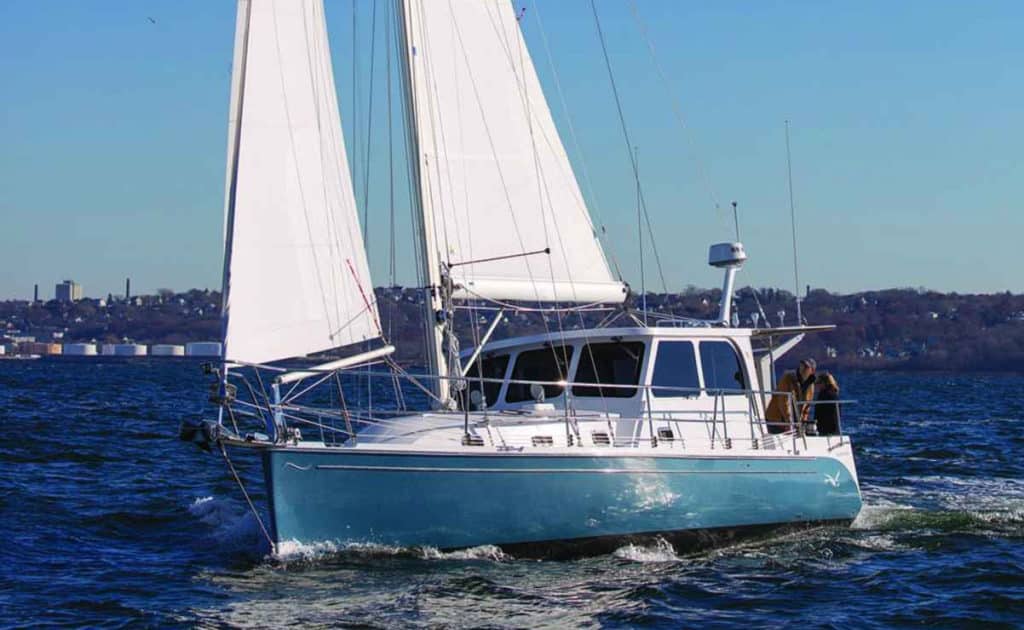
Shannon 38 HPS
